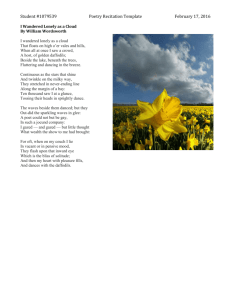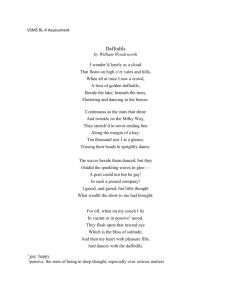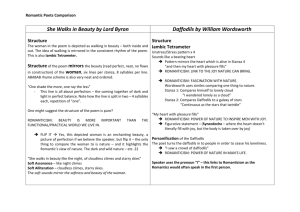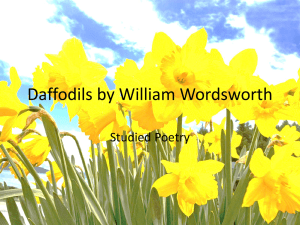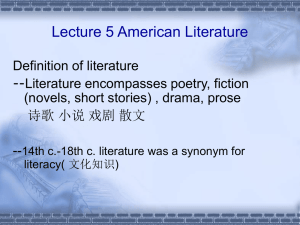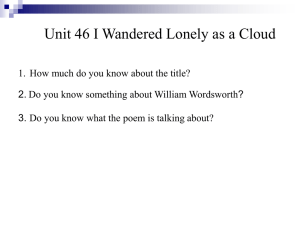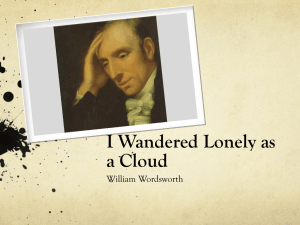daffodils 102 - lagosbooksclub
advertisement
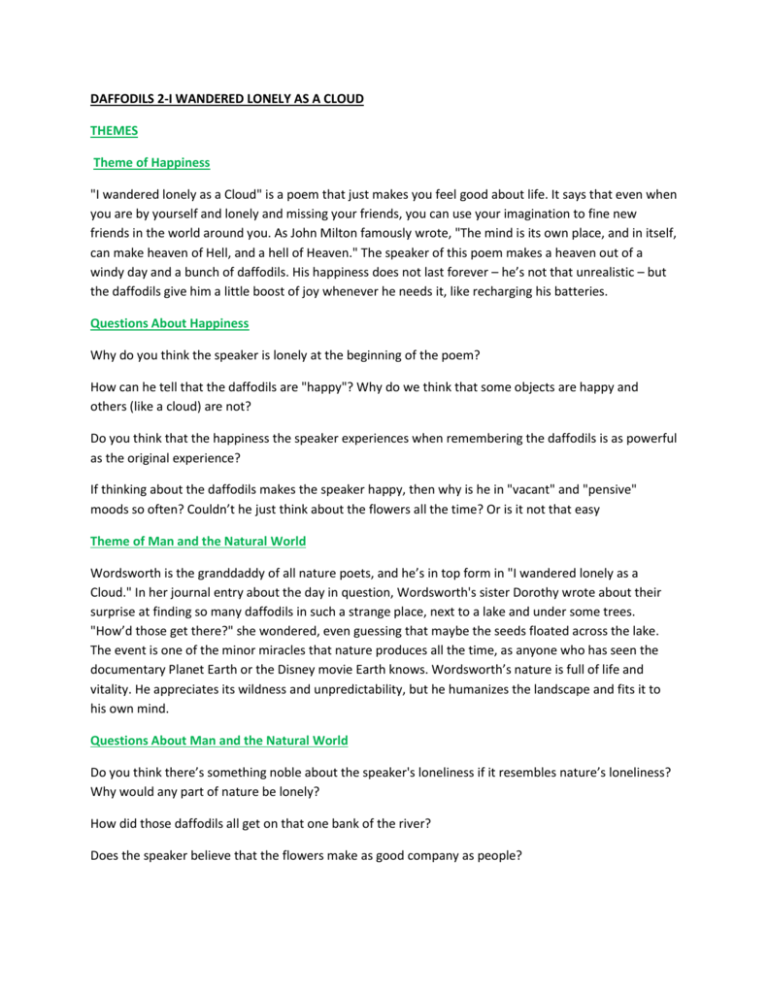
DAFFODILS 2-I WANDERED LONELY AS A CLOUD THEMES Theme of Happiness "I wandered lonely as a Cloud" is a poem that just makes you feel good about life. It says that even when you are by yourself and lonely and missing your friends, you can use your imagination to fine new friends in the world around you. As John Milton famously wrote, "The mind is its own place, and in itself, can make heaven of Hell, and a hell of Heaven." The speaker of this poem makes a heaven out of a windy day and a bunch of daffodils. His happiness does not last forever – he’s not that unrealistic – but the daffodils give him a little boost of joy whenever he needs it, like recharging his batteries. Questions About Happiness Why do you think the speaker is lonely at the beginning of the poem? How can he tell that the daffodils are "happy"? Why do we think that some objects are happy and others (like a cloud) are not? Do you think that the happiness the speaker experiences when remembering the daffodils is as powerful as the original experience? If thinking about the daffodils makes the speaker happy, then why is he in "vacant" and "pensive" moods so often? Couldn’t he just think about the flowers all the time? Or is it not that easy Theme of Man and the Natural World Wordsworth is the granddaddy of all nature poets, and he’s in top form in "I wandered lonely as a Cloud." In her journal entry about the day in question, Wordsworth's sister Dorothy wrote about their surprise at finding so many daffodils in such a strange place, next to a lake and under some trees. "How’d those get there?" she wondered, even guessing that maybe the seeds floated across the lake. The event is one of the minor miracles that nature produces all the time, as anyone who has seen the documentary Planet Earth or the Disney movie Earth knows. Wordsworth’s nature is full of life and vitality. He appreciates its wildness and unpredictability, but he humanizes the landscape and fits it to his own mind. Questions About Man and the Natural World Do you think there’s something noble about the speaker's loneliness if it resembles nature’s loneliness? Why would any part of nature be lonely? How did those daffodils all get on that one bank of the river? Does the speaker believe that the flowers make as good company as people? How much does the speaker’s mood depend on nature, and how much does his perception of nature depend on his mood? Theme of Spirituality The 19th century Scottish writer Thomas Carlyle coined the phrase "natural supernaturalism," which has been used by later critics to describe how the Romantic poets, and especially Wordsworth, viewed the natural world as a spiritual realm. The idea is that Heaven comes down to earth and is viewed as part of the world. This poem illustrates the principle of natural supernaturalism. The daffodils are like angels and twinkling stars, and the "bliss" of heaven occurs in speaker’s imagination. He uses Christian ideas and images to make an ode to nature without any reference to God. Questions About Spirituality Do you agree with us that the daffodils are compared to angels or at least angelic beings? What is the evidence for and against this argument? What is the effect of all the shining and twinkling that occurs in the poem? What is the "inward eye"? Is the word "eye" just a metaphor, or does the speaker mean it literally in some sense? How would you describe the relationship between the earth and the sky/air/atmosphere in the poem? Which realm do the daffodils belong to? Theme of Memory and the Past "I wandered lonely as a Cloud" is almost like a simpler version of "Tintern Abbey," one of Wordsworth’s other most famous works. In both poems, the memory of beautiful things serves as a comfort to the speaker even after the experience of viewing them has ended. He can always draw on his imagination to reproduce the joy of the event and to remember the spiritual wisdom that it provided. In the case of "I wandered lonely as a Cloud," we do not realize just how far in the future the speaker’s perspective is located until the fourth stanza, when he describes just how often the daffodils have comforted him. Questions About Memory and the Past If the speaker could forget his loneliness so quickly, do you think he was that lonely to begin with? Are there kinds of sadness and loneliness that no image, no matter how beautiful, can alleviate? How would you explain the phrase, "but little thought what wealth to me had brought" (line 18)? What does the speaker mean by "wealth"? What is the relationship between happiness or bliss and memory at the end of the poem? Does the speaker make a conscious effort to remember the daffodils, or do they come into his head spontaneously? Is there a middle ground between these two optio QUOTES ON HAPPINESS Quote #1 I wandered lonely as a cloud (line 1) Think of how this poem would sound if "lonely" were omitted. If you can describe a cloud as "lonely," then you could describe it as almost anything: happy, tired, bored, aimless, hopeful. Think about "I wandered hopeful as a cloud." Does that make any less sense? Well, in the context of the poem yes, but by itself, maybe not. "Lonely" seems to be necessary to make the contrast with the happiness of the daffodils. Quote #2 Fluttering and dancing in the breeze. (line 6) The daffodils are first introduced as "dancing" at the end of the first stanza. There is no reason at this point to think that the dancing is especially happy. It could just be your run-of-the-mill metaphor to produce a run-of-the-mill nature description. The description of the daffodils starts out naturalistic and becomes tinged with more and more emotion as the poem goes on. Quote #3 The waves beside them danced; but they Out-did the sparkling waves in glee: (lines 13-14) The fact that the daffodils are happier than the waves suggests that their so-called "happiness" is dependent on the speaker’s perception of them. For example, he probably doesn’t think the waves are as happy because he associates them with the wind and the brewing storm. Waves can make people feel uneasy. But stationary flowers: who’s afraid of a little flower? ON MAN AND THE NATURAL WORLD Quote #1 I wandered lonely as a cloud That floats on high o'er vales and hills, (lines 1-2) If you’re a connoisseur (a big follower) of Wordsworth’s nature poetry (and who isn’t?), you’d probably guess that he’s talking about the famous Lake District in England. Why? Because he’s always talking about the Lake District, his favorite wilderness region this side of Sussex. At the same time as he identifies himself with a part of the surroundings, the clouds, we imagine that he is also "wandering" through the area. Quote #2 They stretched in never-ending line Along the margin of a bay: (lines 9-10) Wordsworth compares the "line" of dandelions stretching from one end of the bay to the other to a band of stars in the Milky Way stretching from one end of the sky to another. He takes an image from nature on earth and makes it seem heavenly, or at least astrological. Quote #3 Ten thousand saw I at a glance, Tossing their heads in sprightly dance. (lines 11-12) That’s a lot of daffodils. That would give you, like, 100 flowers for every day of the spring. ON SPIRITUALITY Quote #1 I wandered lonely as a cloud That floats on high o'er vales and hills, (lines 1-2) The speaker imagines himself elevated above the world, and his loneliness might be a sign of this higher nature. Quote #2 A host, of golden daffodils; (line 4) The word "host" suggests a "heavenly host" or "host of angels." Also, the angels are golden as you might imagine angels would be. They seem to belong to another reality that is nonetheless embedded in nature. There is often no clear divisible between the earthly world and the spiritual world in Wordsworth’s poetry. Quote #3 Continuous as the stars that shine And twinkle on the milky way, (lines 7-8) The image of the flowers as stars points to the images of angels as innumerable stars in the sky, in works like Dante’s Paradiso. The speaker remains elevated above the world, but now he is not so lonely. ON MEMORY AND THE PAST Quote #1 When all at once I saw a crowd, A host, of golden daffodils; (lines 2-3) You don’t think about verb tenses through much of the poem. It reads like a straightforward narrative which, though not set in the present, still has this present-y atmosphere to it because of phrases like "all at once." Quote #2 A poet could not but be gay, In such a jocund company: (lines 13-14) The poem could have worked just fine if it ended here. Sad man becomes happy: a perfect plot. But no, Wordsworth has to be Wordsworth and add more layers of complexity. Quote #3 For oft, when on my couch I lie In vacant or in pensive mood, (lines 19-20) The final stanza hits us with a surprise: the daffodil scene wasn’t something that happened yesterday, or even last week. It happened a while ago. Now the speaker is giving us a memory about his memories. William Wordsworth’s Calling Card What is the poet’s signature style? One of the big ideas of Romanticism is the notion that the spiritual vision – the imagination – can hold greater truths than those given by our senses. We can never fully express what goes on in ourimagination, but the notion of an "inner eye" captures the sense of reality that it gives us. Anyone who has ever read a good book or had a crazy dream knows that the imagination can seem really real. Wordsworth is all about that "inner eye." For example, go check out "Tintern Abbey" on Shmoop, in which he describes the same phenomenon as at the end of "I wandered lonely as a Cloud." After visiting an old ruined church, he goes home and remembers the images in his imagination, just as he remembers the daffodils here. He writes that, "with an eye made quiet by the power of harmony, and the deep power of joy, we see into the life of things. Symbol Analysis-Dance, Dance Revolution In "I wandered lonely as a Cloud," the daffodils are like little yellow people who keep the speaker company when he is feeling lonely. The happiness of the daffodils can always cheer him up, and he can tell that they are happy because they dance. Some variation of the word "dance" occurs in each of the four stanzas. Also, the speaker is taken aback by how many daffodils there are. We often think of daffodils as a flower that people plant in their gardens in the springtime, so it would be surprising to come upon thousands of them by an isolated lake. Lines 3-4: The daffodils are personified as a crowd of people. This personification will continue throughout the poem. Lines 6: Daffodils cannot actually "dance," so Wordsworth is ascribing to them an action that is associated with people. Line 9: The speaker says that the line of daffodils is "never-ending," but we know this can’t be strictly true: all good things come to an end. This is an example of hyperbole, or exaggeration. Lines 12: The personification of the daffodils becomes more specific. The "heads" of the daffodils are the part of the flower with the petals. It is larger and heavier than the stem, and so it bobs in a breeze. (When you think about it, it’s kind of amazing how flowers support themselves at all.) Lines 13-14: The waves also get in on some of the dancing (and personification) action, but the daffodils are not to be out-done – they are happier than the waves. Lines 21-24: Wordsworth imagines the daffodils in his spiritual vision, for which he uses the metaphor of an "inward eye." His heart dances like a person, too.
